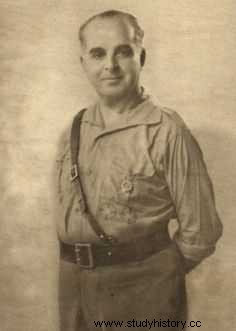
The army of Africa, now less than 65 kilometers from the Madrid park, the Casa de Campo, was commanded by General Enrique Varela, a soldier with a legendary past.
Son of a sergeant major, he joined the army as simple bugler and his bravery had earned him the highest distinctions. He had advanced his troops about 500 kilometers in two months.
To launch the attack on Madrid, General Varela deployed four columns east of San Martin de Valdeglesias and Santa Cruz del Retamar, and one on both sides of the national road from Toledo to Madrid.
On October 15, what was to be the final assault that everyone had been waiting for was unleashed. The entire Varela front moved forward, reaching Illescas, Navalcarnero and Chapineria, 30 or 40 kilometers from Madrid. In desperation, the Republicans launched a counterattack on October 18 at Chapineria and succeeded in breaking through the Nationalist lines. Two days later, 15,000 militiamen attacked Illescas from three axes.
At Chapineria as at Illescas, the Republicans were on the brink of victory, but the Nationalists were able to bring their heavy artillery in support of the German and Italian bombers. The outcome of the battle was decided when Varela engaged the troops he had kept in reserve. Once again the Republicans had to retreat with heavy losses.
Now assured of victory, Varela launched his fresh troops from three home bases, supported by 4 new squadrons of Ju bombers. 52 and nearly 100 Fiat tanks. The Republican air force, which included French aircraft flown by well-trained French crews, was virtually destroyed. The nationalists then enjoyed total air supremacy. In addition, the defenders of Madrid no longer had tanks or anti-tank guns. But somehow, to the astonishment of the entire world, their defenses held firm.
The time saved proved crucial as Soviet weapons were on the way. The brilliant breakthrough of the Spanish Communist Party had indeed
led Stalin to revise his point of view on the Soviet military engagement in Spain:if the Spanish Communists could appear as the defenders of the people against the rebellion of the right, the other communist parties in the world would find themselves strengthened by it.
On his order, the first technicians of the Soviet military aviation arrived in Spain at the beginning of September. Shortly after, the first twelve fighters were disembarked from a Soviet freighter and, on October 16, when the battle for Madrid reached its climax, 18 other fighters, 50 heavy tanks and no less than 100 tank crews as well as 150 men of the Red Army air force reached Cartagena.
General Varela moved his group of mixed cavalry to his right flank, south of Madrid, to drive into a breach that had just be open in the defense of the city. On October 24, the cavalry, with the support of tanks and machine guns, cleared the ground between the roads from Illescas to Madrid and from Aranjuez to Madrid, capturing in the process the small towns of Borox, Esquivias, Seseria and Cuesta de La Reina. The obvious threat to communications between Valencia and Madrid, if this eastward push continued, would force the Republicans to draw on their reserves and their meager stocks of new weapons to counterattack.
On October 28, Francisco Largo Caballero spoke on radio from Madrid, announcing to his troops that planes and tanks had arrived and that they would be able to support a dawn attack. The nationalists were grateful to him for this useful information, but when the Soviet heavy tanks moved from Aranjuez to Se-sella, there were few Moroccan infantry, Spanish horsemen and Fiat light tanks to contain them. In the narrow, winding streets of the old towns, the cannonade wreaked terrible havoc, knocking down machine-gun nests, cutting down horsemen and destroying Italian tanks without opposition. A Russian tank commander even claimed to have destroyed eleven of them.
The tactics used by the Soviet tanks in this battle were particularly significant. The attack on the Nationalist forces was designed in the manner of Blitzkrieg (lightning war), a style of combat devised by German Colonel Heinz Guderian and retained by Soviet experts. The tanks were grouped in massive formation to shock and not scattered on the ground in support of infantry, according to a tactic dear to the French. The astonishing result of this attack was that the Nationalists believed that southern Madrid was better defended than it actually was; likewise in 1940, the successes of the Blitzkrieg led to overestimating German firepower.
Soviet tanks advanced in front of the infantry, supported by machine guns which opened fire immediately after the passage of the shielded. They reached Torrejon, on the national road from Illescas to Madrid, but, lacking infantry support,
they could not consolidate their advantage and were soon forced to withdraw. But the superiority of the Republican tanks and the shelling of the Nationalist rear by the new Soviet bombers proved to Franco that the civil war had entered a new phase; the chances of taking Madrid with a small elite troop seemed definitely compromised.
